Claudia and I have made several trips to California’s Central Valley this winter to photograph birds. It’s one of our favorite things to do this time of year, when large flocks of waterfowl take up residence in the valley’s marshes for a few months before migrating northward in the spring. I love watching and photographing the movements of these flocks, especially the white geese – the snow geese and Ross’s geese. Seeing 10,000 geese take off in a single, noisy, coordinated wave is simply awe-inspiring, but there’s magic and beauty in their smaller comings and goings as well.
My approach to photographing wildlife is similar to my approach to photographing landscapes. Rather than making closeup photographs of individual animals, I’m trying to incorporate the animals into the landscape, looking for ways to capture a mood and convey what it felt like to be in a particular place at a particular time, watching a unique and beautiful moment.
Of course in nature photography we have little control over our subjects. We can’t control the light, or weather. We have no influence on where mountains form, trees grow, or rivers flow. And we certainly can’t dictate the movements of animals. But we can get to know our subjects. You can visit a place over and over to discover the most interesting viewpoints. You can observe how the weather behaves in that area, and which spots might work best under different weather and lighting conditions. And you can learn the habits and movements of wildlife. None of that guarantees anything, but every bit of knowledge increases your odds of being in the right place at the right time.
You can also learn to recognize the visual elements that help to convey a mood and tell a story. An old, twisted, gnarled tree suggests a different feeling, and a different idea, than a young sapling. Sunbeams breaking through dark clouds convey a different mood than thick fog. A high contrast image feels different than a low contrast image. Crimson reds create one feeling, while pastel blues create another. Again, we can’t control the light, or the colors of our subjects, or what trees grow where. But we can learn to recognize, and even anticipate, when the subject, light, weather, color, tone, and composition might come together to create a photograph with a strong, cohesive message.
The photograph above required that kind of recognition. Claudia and I arrived at this foggy marsh well before sunrise. We knew likely places to look for geese, since we were familiar with this area and the habits of the birds. When we first got there it was too dark to see the geese, but we could hear them honking, and judged that there were probably several thousand birds out there in the fog.
I knew immediately that this was a promising situation. Not just because there were birds nearby, but because many elements could work together to tell the visual story of a foggy morning in the marsh. There was a low layer of fog, with high clouds above that were likely to turn color at sunrise. I’d seen that situation before, and knew that could be a beautiful combination, with the color shining through the fog. Since we’d been to this spot before I knew that this marsh was a great setting, with interesting reeds, and a row of cottonwood trees in the background. The combination of geese, reeds, cottonwoods, and fog said “marsh” or “wetland” strongly, and would help to convey a sense of place. The fog and color would suggest a particular time of day – sunrise. The fog, pastel colors, white birds, trees, and reeds could all work together to add a soft, delicate feeling to a photograph.
As we waited for sunrise, more geese arrived and landed in the marsh, gathering before they flew out to feed. As sunrise approached the fog got thicker, but then it thinned again, revealing thousands of geese spread out across the marsh. The sky turned pink behind the fog, just as I had hoped. I noticed a line of lacy-looking plants growing out of the marsh, surrounded by geese. These plants seemed to fit the soft, delicate mood of this scene, so I moved my camera position in order to incorporate them into my composition. Then I waited for geese to fly into the picture.
The geese started to take off in small groups, so I fired off many frames as they flew past, hoping that they might arrange themselves into an interesting pattern in one of them. I liked the arrangement in the photograph above because it has a fairly cohesive pattern, and a sense of depth created by birds flying at different distances from the camera. Later, the geese started lifting off in larger groups, and finally all the remaining birds took off in one wave, as shown in the first image below. That photograph is more dramatic, while the one above is quieter, but they both have a mood, and both tell a story about watching a unique and beautiful moment at a particular place and time.
Of course I didn’t have control over any of this, and there was a lot of luck involved, but it helped to know the area, the bird’s habits, and the weather patterns. Better yet, I had a moment of recognition, a visualization of how the subject, light, weather, tones, color, and composition could work together to tell a cohesive story and create a mood.
— Michael Frye
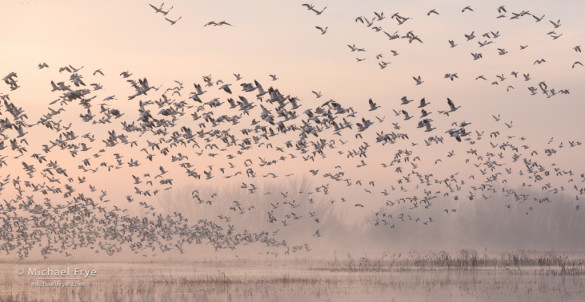
Ross’s geese taking flight at sunrise, San Joaquin Valley. This was captured about ten minutes after the photograph at the top of the post, as the last group of geese took off in one large wave.
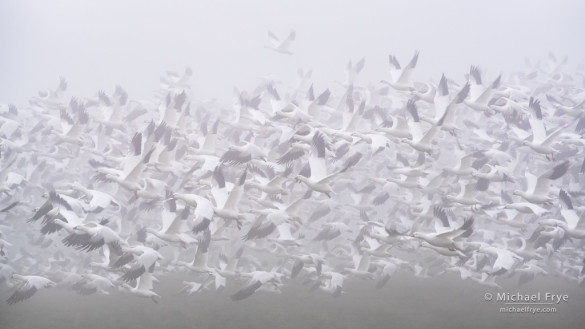
Ross’s geese taking flight in fog, San Joaquin Valley. I made this photograph on a different day, with thicker fog. Driving down a dirt road we spotted a line of white through the fog – a large flock of geese feeding in a pasture. About two minutes after we arrived the birds all flushed, but luckily I was ready. The thick fog helped to create a sense of depth, and added a soft, delicate feeling to the photograph.
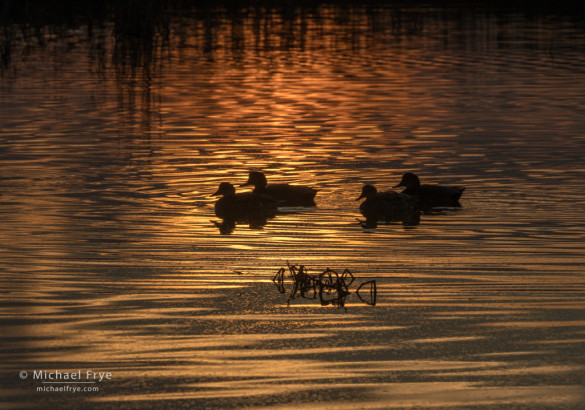
American wigeons at sunset, San Joaquin Valley. A brilliant sunset reflected in a pond where these ducks were feeding. The hardest part was getting the ducks to pull their heads out of the water and all face the same direction.
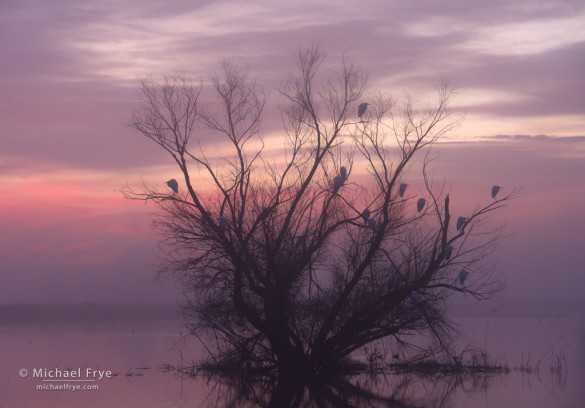
Great egrets roosting in a willow at sunrise, San Joaquin Valley. We stumbled upon this tree where a group of egrets had spent the night. This was another sunrise with a thin layer of fog, and high clouds lighting up behind them.
Related Posts: Capturing a Mood; Light and Mood With Intimate Landscapes
Did you like this article? Click here to subscribe to this blog and get every new post delivered right to your inbox!
Michael Frye is a professional photographer specializing in landscapes and nature. He is the author or principal photographer of The Photographer’s Guide to Yosemite, Yosemite Meditations, Yosemite Meditations for Women, Yosemite Meditations for Adventurers, and Digital Landscape Photography: In the Footsteps of Ansel Adams and the Great Masters. He has also written three eBooks: Light & Land: Landscapes in the Digital Darkroom, Exposure for Outdoor Photography, and Landscapes in Lightroom: The Essential Step-by-Step Guide. Michael has written numerous magazine articles on the art and technique of photography, and his images have been published in over thirty countries around the world. Michael has lived either in or near Yosemite National Park since 1983, currently residing just outside the park in Mariposa, California.

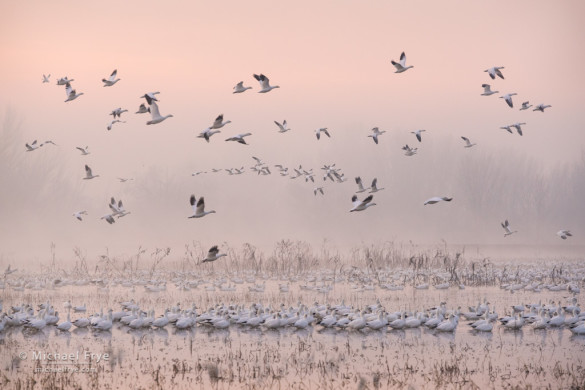








first!
Hi Michael,
Brilliant photos!
Cheers,
Alyn Brereton
P.S. Please let me know when you have openings for future workshops in Yosemite.
Thanks Alyn – will do.
Michael, Thanks! Alyn